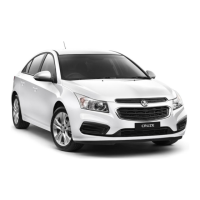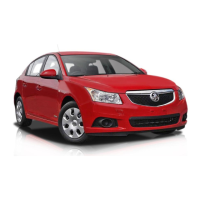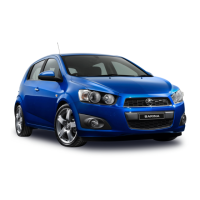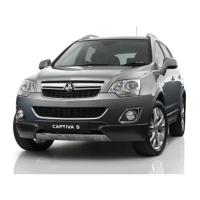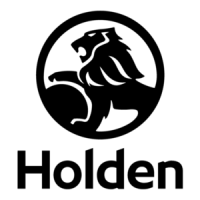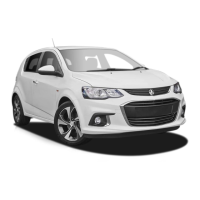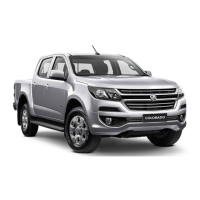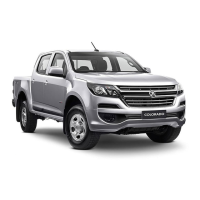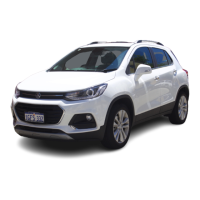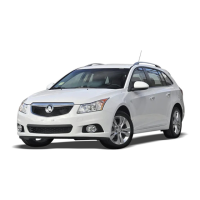
Do you have a question about the HOLDEN JH CRUZE and is the answer not in the manual?
| Brand | HOLDEN |
|---|---|
| Model | JH CRUZE |
| Category | Automobile |
| Language | English |
Explains how to navigate and understand the manual's structure and symbols.
Covers essential information for the first drive, including keys and seat adjustments.
Details how to adjust front seats, including position, backrest, and head restraints.
Instructions on how to properly use and adjust seat belts for safety.
Covers adjustment of interior and exterior mirrors for optimal visibility.
Explains how to adjust the steering wheel for comfortable driving position.
Provides a visual guide to the layout and components of the instrument panel.
Details the operation of headlights, parking lights, and fog lights.
Explains the function and operation of turn signals and hazard warning flashers.
Covers the operation of windscreen wipers, washers, and rear window wipers.
Explains the climate control system, including heated rear window and air conditioning.
Details manual and automatic transmission operation, including gear selection and modes.
Covers pre-start checks and the process of starting the engine using the ignition switch.
Information on replacement keys, key numbers, and the foldaway key section.
Explains the operation and features of the radio remote control for vehicle access.
Details the functionality of the electronic key for vehicle operation without a mechanical key.
Procedures for unlocking the vehicle using remote control or electronic key.
Steps for locking the vehicle using remote control or electronic key system.
Automatic locking features after driving off and configuration options.
How to use child locks for rear doors and their operation.
Details automatic locking after driving off and child lock system for rear doors.
Instructions for opening and closing the load compartment (hatchback and sedan).
Explains the anti-theft alarm system, its activation, and status indicator.
Details how the immobiliser system prevents unauthorized starting of the vehicle.
Covers convex shape, electric adjustment, and folding mirrors for safety.
Manual anti-dazzle adjustment for the interior mirror to reduce glare.
Operation of power windows, including safety functions and overload protection.
Information on head restraint position, height, and horizontal adjustment for safety.
Guide to proper seat positioning for comfort and safety, including steering wheel reach.
Details seat adjustment procedures, including danger and warning notes for airbag deployment.
Covers seat belt usage, reminders, and safety warnings for proper fastening.
Explains the function of belt tensioners and warnings related to their handling.
Fitting instructions and height adjustment for the three-point seat belt.
Specific advice for pregnant women on seat belt usage during pregnancy.
Overview of the airbag system, including front, side, and curtain airbags.
Information on child restraint systems, installation, and permissible locations.
Details various storage compartments, including a warning about heavy objects.
Describes the storage compartment located on top of the instrument panel.
Instructions on how to open the storage box located below the light switch.
Information on opening the glovebox and a warning about keeping it closed while driving.
Location and description of cupholders in the centre console and rear armrest.
Information on the sunglasses storage compartment, if fitted.
Details storage within the front armrest, including sliding and folding features.
Instructions for folding down rear seat backrests to access the load compartment.
Information on rear storage trays and removing/installing them.
How to remove and fit the load compartment cover for hatchback and Sportwagon models.
Instructions for unlocking, lifting, and placing the rear floor storage cover.
Information on lashing eyes for securing items and the use of safety nets.
Recommendations for roof rack installation and maximum load capacities.
Guidelines for loading the vehicle safely, including object placement and securing.
Overview of vehicle controls, including steering wheel adjustment and controls.
How to operate the vehicle's horn.
Operation of windscreen wipers and washers, including adjustable wiper interval.
Details on using the windscreen washer system.
Operation of the rear window wiper and washer system.
Information on temperature display and warnings for icy road conditions.
How to set and display the date and time.
Setting date, time, and other display preferences in the Colour-Info-Display.
Location and usage of 12V power outlets, including maximum power consumption.
Explanation of various warning lights, gauges, and indicators on the instrument panel.
Displays recorded distance and trip odometer information.
Shows engine revolutions per minute and advice on low engine speed range.
Indicates fuel level in the tank and warnings for low fuel.
Displays coolant temperature and warnings for overheating.
Engine oil life system for diesel engines and when to change engine oil.
Description of various control indicators and their meanings by color.
Function and indicators for turn signals, including flashing and failures.
Seat belt reminder for front seats, illumination, and flashing indicators.
Indicators for airbag and belt tensioner faults and their meaning.
Indicator for the charging system status.
Illuminates for parking brake, fluid level, or brake system faults.
Explains ABS function and indicators for faults.
Indicators for reduced or disabled power steering due to overheating or system failure.
Operation of ultrasonic parking assist, including indicators and fault conditions.
Functionality and indicators for Electronic Stability Control (ESC) and Traction Control (TC).
Information on the diesel particle filter, cleaning process, and indicator lights.
Indicator for engine oil pressure and actions in case of low oil pressure.
Indicator for low fuel level and the need to refuel immediately.
Indicator for the immobiliser system and potential faults.
Displays message on DIC when brake or clutch pedal needs to be depressed to start.
Indicator for parking lights and exterior lights.
Indicator for high beam activation and headlight flash.
Indicator for front fog lights when they are switched on.
Indicators for cruise control system status (on or stored speed).
Indicator for open doors or boot lid.
Details about the Driver Information Centre (DIC) display.
Explains how vehicle messages are displayed via DIC and lists common messages.
Situations that trigger warning chimes when starting or driving the vehicle.
Conditions that trigger warning chimes when the vehicle is parked or door is open.
How to select menus and functions for trip computer, average consumption, range, etc.
How to personalize vehicle settings in the Driver Information Centre and Info-Display.
Operation of the light switch, including AUTO mode, parking lights, and headlights.
How automatic light control switches headlights and taillights based on ambient conditions.
Instructions on switching between low and high beams and warnings for misuse.
How to activate the headlight flash function.
Operation of hazard warning flashers and automatic activation during airbag deployment.
Operation of turn signals, including lever positions and automatic deactivation.
Operation of front fog lights, if fitted.
When reversing lights turn on, based on ignition and reverse gear selection.
Explanation of misting inside light housings and how it disappears.
Instrument panel illumination control and adjustment of interior light brightness.
Automatic operation of courtesy lights during entry and exit.
Operation of interior reading lights using specific buttons.
Entry lighting (welcome and entrance) and exit lighting functions.
Automatic switching off of interior lights to prevent battery discharge.
Overview of air conditioning systems and controls for temperature, fan speed, etc.
Adjustable air vents and directions for airflow, with a warning about icing.
Air intake cleaning and pollen filter information for optimal air conditioning.
Recommendations for regular operation of the air conditioning system for efficient performance.
Recommended annual checks for the climate control system by a Holden Dealer.
Function of the air quality sensor and automatic switching to internal air.
How to switch the heating, ventilation, and cooling system on or off.
How to change settings in the Vehicle Settings menu for climate and air quality.
Steps to achieve maximum cooling by adjusting airflow and settings.
How changes in climate control settings are indicated on the Info-Display.
Operation of the electronic climate control system, which is fully operational when the engine is running.
How to adjust airflow for demisting and defrosting windows.
How climate control settings can be changed manually, deactivating automatic mode.
How to adjust fan speed using the right rotary knob and number display.
How to adjust air distribution using the MODE button and its indication on the Info-Display.
Activating or deactivating the air conditioning system and its operation.
Operation of the manual air recirculation mode using a specific button.
General advice on controlling the vehicle, including not coasting with the engine off.
Ensuring pedal travel is uninhibited by removing mats in the pedal area.
New vehicle running-in procedures to improve performance and longevity.
Explanation of ignition switch positions (0, 1, 2, 3) for starting the engine.
Step-by-step guide to starting the engine using the ignition switch.
Process for starting the engine using the Start/Stop button with an electronic key.
How to switch off the engine using the Start/Stop button.
Activating accessory power mode and its functions without the engine running.
Activating ignition on power mode for operating electrical functions and preheating.
Procedure for unlocking/locking the vehicle with the mechanical key when the electronic key fails.
How fuel supply is automatically cut off during overrun when the accelerator is released.
Safe parking procedures, including brake application and wheel positioning.
Dangers of engine exhaust gases and actions to take if they enter the vehicle.
Function of the diesel particle filter and its self-cleaning process.
Function of the catalytic converter and precautions regarding fuel and starting.
Operation of automatic transmission, including gear shifting and transmission display.
Positions of the selector lever (P, R, N, D) and how to operate it.
How to activate sport mode for maximum responsiveness and its effects on transmission.
How to shift gears manually using the shift lever and its limitations.
How kickdown works by pressing the accelerator pedal past the pressure point.
Cold start temperature program and automatic neutral shift function.
What happens when a fault occurs in the transmission and related indicators.
Procedures for shifting lever out of P when power supply is interrupted.
Manual procedure to release the shift lever from P position in case of power interruption.
Information on the brake system, including dual circuits and brake servo unit.
Explains ABS function and indicators for faults.
How to apply and release the parking brake firmly.
How brake assist automatically applies maximum brake force during forceful pedal application.
Traction Control (TC) and Electronic Stability Control (ESC) systems for driving stability.
How to store and maintain speeds using cruise control, and activation conditions.
Steps to switch on cruise control and activate it to store a speed.
How to reduce speed while cruise control is active.
How to resume a previously stored speed with cruise control.
How to switch off cruise control and delete stored speed.
Parking assist functionality, activation, deactivation, and fault conditions.
How the rear view camera assists during reversing and its display in the Colour-Info-Display.
Fuel recommendations for petrol and diesel engines, including ethanol content and biodiesel.
Safety instructions for refueling, including switching off the engine and mobile phones.
General information on trailer towing, including vehicle design and handling.
Maximum towing capacities for different engines and transmissions, and mandatory equipment.
Recommendations for using genuine parts and accessories, and warnings about vehicle modifications.
Performing work on the vehicle, with warnings about engine compartment checks and high voltage.
Procedures for opening and closing the vehicle's bonnet.
Visual diagrams showing engine compartment components for different engine types.
How to check and top up engine oil, including dipstick usage and caution for slopes.
Instructions on how to replace the engine air filter by unscrewing screws.
Information on coolant properties, level checks, and warnings about spilling.
Caution regarding contamination of power steering fluid and checking its level.
Warnings about brake fluid being poisonous and corrosive, and proper topping up procedures.
Information on the vehicle battery, its maintenance, and precautions for non-use.
Instructions for filling the washer fluid reservoir with a cleaning solution.
Procedure to bleed the diesel fuel system if the tank has run dry.
How to replace wiper blades on the windscreen and rear window.
General instructions for bulb replacement, including halogen headlights and parking lights.
How to replace bulbs in the front turn signal lights.
Recommendation to have fog light bulbs replaced by a Holden Dealer.
Instructions for replacing bulbs in tail lights for sedan, hatchback, and Sportwagon models.
Procedures for replacing bulbs in tail lights located in the boot lid.
How to replace bulbs in the number plate light for sedan models.
How to replace the bulb in the boot compartment light.
Replacement of bulbs for courtesy and reading lights.
Recommendation to have instrument panel illumination bulbs replaced by a Holden Dealer.
Information on fuses, fuse boxes, and the fuse extractor tool.
Location and removal of the fuse box cover in the engine compartment.
Location of the fuse box behind the glovebox cover.
Information on tools provided with the vehicle, including tyre repair kits and spare wheels.
Tyre condition, pressure checks, tread depth, and replacement reasons.
Regulations and usage of tyre chains, specifically for front wheels.
Instructions for using the tyre repair kit for minor damages and warnings.
General procedures and safety precautions for changing a wheel.
Location and securing of the spare wheel, including different wheel types.
Warnings and precautions for using a temporary spare wheel.
Fitting directional tyres and considerations for tyres fitted against rolling direction.
Procedures and safety warnings for jump starting a vehicle with a discharged battery.
Instructions for towing the vehicle using a towing eye and associated precautions.
Exterior care, including washing, bird droppings, and road bloom removal.
Rectifying minor paintwork damage and repairing extensive damage or rust.
Information on underbody coating and the need for inspection after washing.
Cleaning the vehicle interior, instrument panel, and upholstery with specific products.
Cleaning and protecting leather upholstery, including application of revitaliser and protector.
Cleaning plastic and rubber parts using interior cleaner and avoiding solvents.
Importance of maintenance at proper intervals and referencing the service booklet.
Ensuring economical and safe operation through timely maintenance.
Computer system indicating when to change engine oil and filter based on driving patterns.
Using recommended fluids and lubricants, and consequences of using non-specified products.
Identifying engine oil quality and viscosity, and selecting the right engine oil.
Using silicate-free long life coolant and maintaining its concentration for protection.
Using DOT4 brake fluid, its moisture absorption, and replacement intervals.
Using Dexron VI fluid for power steering and avoiding contamination.
Using Dexron VI fluid for the automatic transmission.
Location of the Vehicle Identification Number (VIN) on the vehicle.
Information contained on the vehicle's identification labels and plates.
Location of the engine serial number for different engine variants.
Recommended fluids and lubricants, including engine oil specifications and capacities.
Technical specifications for different engines, including cylinders, displacement, power, and torque.
Maximum vehicle payloads and axle loads for different models and configurations.
Physical dimensions (length, width, height, wheelbase) for different vehicle body styles.
Fluid capacities for engine oil, engine coolant, and fuel tank.
Recommended tyre pressures for different loads and tyre sizes for sedans and hatchbacks.
Recommended tyre pressures for Sportwagon models under various load conditions.
Options for seeking assistance with vehicle ownership experience from Holden.
Contacting Holden Customer Care for support and satisfaction with ownership.
Encouragement to seek assistance from Holden Dealerships for sales, servicing, and technical queries.
Contact details and operating hours for the Holden Customer Care team.
Alternative contact method via email to Holden Customer Care.
Address for written correspondence to Holden Customer Care Centre.
Information specific to New Zealand vehicles and contact details for assistance.
